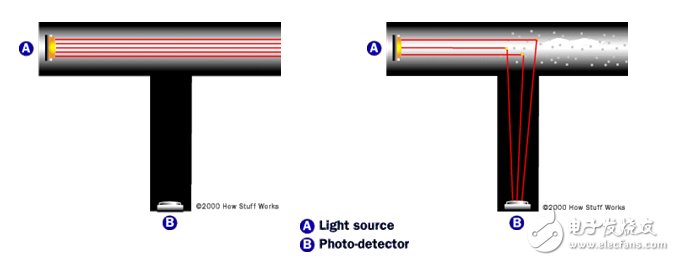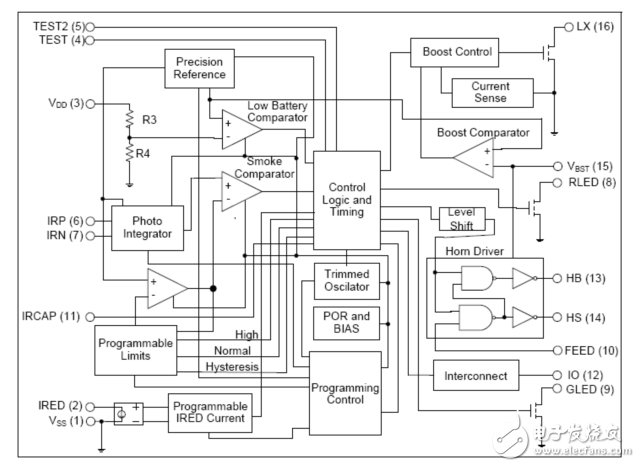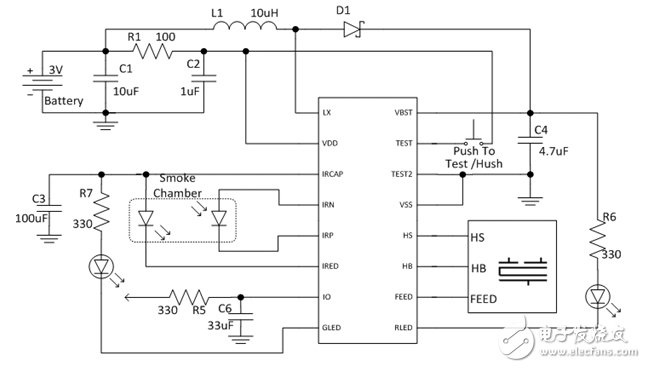This article describes the RE46C190 from Microchip (US Microchip Technology) for the implementation of 3V photoelectric smoke detectors.
introduction:
Photoelectric smoke detectors are one of the main detectors currently used in fire protection. Traditional photoelectric smoke detectors mainly have two implementation methods: a single-chip based solution or a dedicated ASIC solution. Dedicated ASIC chips are widely used due to their high level of integration and the number of peripheral components required. At present, the ASIC chips commonly used in the market generally use 9V power supply, and the battery cost is relatively high. At the same time, most of the chips adopt peripheral separation components to set relevant parameters, and the production debugging cost is also relatively expensive. Microchip's industry-leading 3V programmable optoelectronic smoke sensor chip RE46C190 for optoelectronic smoke detectors, integrated with smoke detection and boost drive, and programmable calibration and multiple operating modes, greatly simplifying photoelectric smoke The development and manufacture of the sensor, while the chip's low power consumption, can be used for 10 years with a single lithium battery.
text:
The photo-electrical smoke detector is an "active" detector, and its working principle is shown in Figure 1. When there is no smoke, the photoelectric receiving diode cannot directly receive the light signal emitted by the infrared light emitting diode. When a fire occurs, the smoke diffuses into the labyrinth of the detector to scatter the emitted light of the infrared light emitting diode, thereby making the photoelectric receiving diode It is capable of receiving a scattered light signal, the size of which indicates the concentration of smoke and also indicates the extent to which the fire burns.

Figure 1. Principle of photoelectric smoke detector
The smoke sensor main control chip recognizes the output signal of the photoreceiving diode and amplifies it, and ensures that the alarm signal is triggered when the signal reaches a certain intensity, that is, when the smoke reaches a certain concentration. Figure 2 shows the internal functional block diagram of the RE46C190. Among them, the driving current of the infrared photodiode, the amplification factor of the phototube amplifier and the integral time constant, the smoke alarm threshold, and the battery low voltage alarm threshold are all programmable, which provides great convenience for different designs. At the same time, the chip also provides individualized function settings such as alarm sound options, mute options, ten-year expired alarm options, and baseline drift correction options, so that the same design can be applied to different product lines. Since the RE46C190 is powered from 3V, the device also integrates a boost controller to provide the voltage required to drive the buzzer alarm.

Figure 2. Internal functional block diagram of the RE46C190
Figure 3 shows the block diagram of the photoelectric smoke detector using RE46C190. The figure includes complete photodiode drive, photoreceiver diode signal processing, boost drive, alarm indication drive and networking. The circuit contains two status indication LED drivers, where the RLED provides drive current to indicate low battery voltage, smoke alarm and silent mode; GLED is used to indicate alarm register status, which is used for quick alarm point when networking confirm.

Figure 3. Block diagram of the RE46C190
The RE46C190 has a built-in crystal oscillator and control unit. The standby circuit will operate for 10 ms every 10 s in standby mode. Before the end of this 10 ms, the infrared emitting diode will work 100-400 ms according to the time programmed by the user; at the same time, the signal received by the infrared photocell will be converted into an electrical signal integrated in the chip, and limited with the internal storage of the chip. Values ​​are compared to determine if smoke is present. If smoke is detected, the system will continue to detect, smoke is detected three times in a row, the system will enter alarm mode, the boost circuit will provide enough drive capability to cause the buzzer to issue a sufficient decibel alarm, and the IO pin will be pulled high.
The RE46C190 provides 11 programming and test modes. Different parameters can be programmed in different modes. All configuration words will be stored in the EEPROM inside the chip.
The average standby current of the whole circuit is about 8 mA. In order to achieve the 10-year requirement of 3V system operation, it is also necessary to consider the internal resistance of the battery and the self-discharge rate. Normally, a battery of around 1500 mAh can meet this requirement.
in conclusion
The RE46C190 provides a single-chip solution for 3V photoelectric smoke detectors. The programmable features of the chip make the system design very flexible and provide a solution designed to meet the needs of different products.
303/304/501 Switch Lines,Data Transmission Line,Usb To Micro Charging Line,Usb-C Charging Line
ShenZhen Puchen Electronics Co., Ltd. , https://www.szpuchen.com